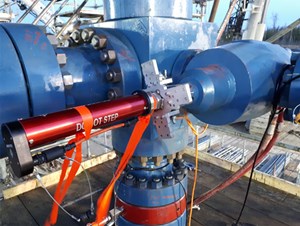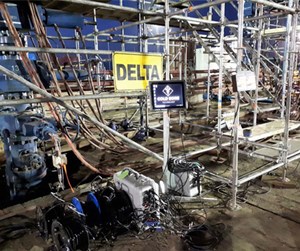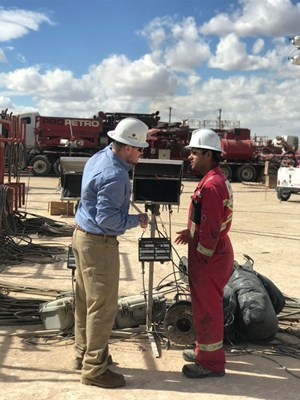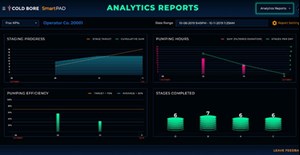Setting the stage for clean fracing
Picture a world where hydraulic fracturing isn’t considered a “dirty” enterprise. Where it’s not the target of environmentalist attack, government prohibition or public derision. Where, because it is carried out in a carbon-neutral way, contributing to a reduction in GHG emissions, fracturing is considered clean and progressive, one useful solution to the climate crisis. While not today’s reality, sustainable, environmentally-friendlier hydraulic fracturing is possible— indeed more achievable—than you might think.
CARBON MANAGEMENT
The digitization of well completions, in conjunction with the use of a carbon footprint management and reporting platform, can help operators to not only reduce GHG emissions from completions, but do so in a measurable and real-time way, that is both actionable and reportable. Once a major contributor to a well’s life cycle of emissions, completions can be greened.

Today, the tools for carbon management from fracturing are generally poor. Typically, spreadsheet-driven, they estimate emissions after-the-fact, producing imprecise assessments not useful for real-time decision-making. With the digitization of well completions, sensors at the wellhead provide automated data that are captured in real time by IIOT sensor-driven software, Fig. 1. These data, from upwards of six to 10 different service companies, are formatted and time-stamped, providing an accurate, verifiable operational time series, Fig. 2. The fully autonomous system is visible and accessible.

Value derived. Efficiencies gained from this automation allow for faster completions, meaning less time on the pad and a concomitant reduction in GHG emissions from those completions. For example, with a completions master control system, Hibernia was able to shave 15 days off a four-pad program. That’s a 15-day reduction in the amount of time that diesel- or natural gas-burning assets (i.e., fracturing pumps) are working on site. The result is a quantifiable reduction in emissions. An autonomous hydraulic fracturing system also allows the operator and service companies to track and audit, with accurate contextual relevance, all the commodities used on location. In particular, water and chemical usage, and any reduction in their usage, can be measured and audited by all parties, Fig. 3.

Add to this an enterprise emissions reporting platform, which uses the digitized completions data and emissions calculations algorithms to provide meaningful context around an operator’s carbon footprint metrics, and you have real-time emissions data that can be used to make further reductions. It could be as simple as an adjustment to the gear and rate that the fracturing pumps run at, whether or not the pumps are idling when there’s no fracturing happening or the number of trucks used to haul water, to more complex questions around how to design well completions differently to reduce emissions. Whereas before these adjustments were made after-the-fact using estimates, they can now be made precisely, while completions are occurring, to optimize production and materially reduce emissions.
Net-zero completions are consequently much more achievable than previously thought. Once an operator has a complete picture of its GHG emissions from completions, it can remediate the leaks and/or purchase offsetting credits to achieve an environmentally friendlier operation.
Improving emissions reporting and auditing. In addition to the more than 700 pages of GHG protocol already coded into the Persefoni platform, it offers reporting to comply new regulations and reporting standards on the horizon. This year, the European Union is moving to strengthen the Non-Financial Reporting Directive, which already mandates certain ESG requirements be reported. And now ESG standards—specifically carbon emissions—are being adopted and consolidated by the International Financial Reporting Standards organization, which establishes the financial reporting rules used by most of the world.
A real-time carbon dashboard would enable operators to adapt quickly to these standards, generate compliance reports for the major reporting standards and, perhaps most importantly, be industry leaders in avoiding emissions, Fig. 4. It also will help attract capital, as major investors are now requiring companies to report their carbon footprint: 1) BlackRock announced that it will vote against the management of companies who fail to report carbon; and 2) TPG, the world’s fourth largest private equity firm (TPG uses Persefoni to assess the carbon impact of its portfolio) is another example of the scrutiny on carbon coming from financial firms. Energy investors, like Rice Investment Group, are attracted to companies that deploy technology to scale business efficiently, with a particular interest in those that are driving declines in emissions.

Moving toward net-zero. As such, major corporations around the world are taking meaningful action to reduce their emissions and green their businesses, many with the ultimate goal of net-zero emissions in the near future. In the oil and gas industry, BP announced in February 2020 that it aims to achieve net-zero emissions across its operations and production by 2050 or sooner, as well as cut the carbon intensity of the products it sells by 50%. In July, Apple announced plans to be net zero by 2030 and in October, American Airlines likewise committed to net zero emissions by 2050. A slew of other companies—from banks to pharmaceuticals, furniture to broadcasting businesses—have all aligned their strategies and brands to put net zero at the forefront of their businesses.
Apparel giant Nike announced its Move to Zero initiative in 2019, to minimize the company’s environmental footprint and maximize avenues for positive impact as a brand. Specifically, the initiative included a commitment to power owned-and-operated facilities with 100% renewable energy by 2025 and to reduce carbon emissions across the global supply chain by 30%, by 2030. Prioritizing environmental responsibility is not a new thing for Nike. For over a decade, the sporting wear giant has focused on developing digital technologies to drive its emissions reduction efforts. As a result, it has become a leader in its field. With approximately 70% of its environmental impact traced to materials in its products, Nike has prioritized reducing its carbon and energy impacts in the materials stage of its value chain.
Sustainability index. To track the environmental impact of its products, Nike began developing a Material Sustainability Index (MSI) in 2003, to track the average carbon footprint of a unit of product. The purpose was to provide a practical method to help designers make informed, real-time decisions about the potential and various environmental impacts of material choices in the product creation process. The MSI calculates relative material scores for each of the more than 80,000 materials available to product creation teams from 1,400 suppliers. It examines the materials from the beginning to the finished textile or component part. Officially launched in 2012, the MSI balances scoring, based on three categories of points: base material score, material environmental attributes and supplier practices. Since put to use, the company has demonstrated significant improvements in its material measurements.
In an effort to promote transparency and collaboration across its industry, Nike shared the MSI with the Sustainable Apparel Coalition (SAC) in 2012. The tool became the Higg MSI, now part of the Higg Index Suite, an industry-standard tool used to measure the impacts of a product from cradle-to-gate in the apparel, footwear and home textile industries. By integrating the Higg MSI into digital tools, companies choose better materials to create more sustainable products with lower environmental impacts. The Higg tools allow manufacturers to instantly see the potential impact on the company’s water, energy, carbon emissions and waste production across the entire supply chain.
In its 2025 target-setting process, Nike was able to set specific goals on the key materials and processes that are the primary carbon drivers in its creation value chain. In collaboration with material and contract factories, the company gained better alignment and access to data to identify progress. It plans to leverage its digital tools to further educate its teams and empower them to make more sustainable decisions. The company’s commitment to transparency across its operations and being a leader in its industry—something oil and gas operators can’t afford not to do in their own businesses. Now is the time for leaders in the completions industry, who are willing to adopt the necessary technologies to propel them, and their peers, forward.
GREEN FRACING
Nike is a great example of a company employing digitization to reduce its environmental footprint. Its green path, albeit further traveled than that of hydraulic fracturing, is one that our industry can emulate. By adopting the right digital tools for the job, sporting apparel and frac companies, alike, can reduce their environmental impacts in both measurable and actionable ways.
So, while hydraulic fracturing is still receiving loud criticism, the digital technologies exist to transform it into a sustainable, clean industry. Not only will it continue to provide low-cost oil and natural gas for North America for years to come, which will facilitate the move away from emission-intensive coal-generated electricity, it also will foster energy security for the continent. This, while operating in a carbon-neutral way. Green well completions are achievable, for those operators bold enough to pursue them. The digital tools need only be employed.
- Advancing offshore decarbonization through electrification of FPSOs (March 2024)
- Digital transformation/Late-life optimization: Harnessing data-driven strategies for late-life optimization (March 2024)
- Shale technology: Bayesian variable pressure decline-curve analysis for shale gas wells (March 2024)
- The reserves replacement dilemma: Can intelligent digital technologies fill the supply gap? (March 2024)
- Digital tool kit enhances real-time decision-making to improve drilling efficiency and performance (February 2024)
- U.S. oil and natural gas production hits record highs (February 2024)


